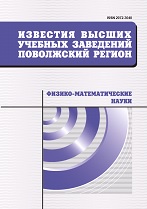|
Physics
A theoretical research of properties of greaphen's nanoclusters as their sizes increases
A. A. Vanchugov, G. I. Mironov
Mari State University, Yoshkar-Ola
Abstract:
Background. Much attention is devoted to the study of the fundamental properties of graphene. The purpose of this paper is to study changes in the energy spectrum, the equation for the chemical potential energy of the ground state and electronic state density on the growth of graphene nanocluster size. For this purpose, we took hex as a structural element of graphene surrounded it in a first step a layer of the same such as hexagons, in the second stage of the hexagon surrounded by two layers of hexagons, have not yet reached to 384 carbon atoms in the nanocluster graphene with eight layers of hexagons. Materials and methods. To describe the properties of real graphene nanoclusters, we constructed a model, in which we assume that the main contribution to the physic-chemical properties of graphene is made by pi-electrons, since the energies of the sigma electrons forming covalent bonds with three neighboring carbon atoms lie below the energy of pi-electrons. Pi-electrons form a system with strong electron correlations, thereofore we use the Hubbard model to describe the properties of graphene nanoclusters. Results. The Fourier transforms of the anticommutator Green's function for the atom, the present atom, designated by index 1 are calculated. When all other atoms have the same environment as atom 1, for all other points of the central hexagon the Fourier transform of the anticommutator Green's function will have the same form as and for an atom with index 1. The poles of the Fourier transforms of the Green's functions determine the energy spectrum of the quantum system under consideration. Then, the energy of the main co-direction and the density of electronic states for controlling the atoms of the central hexagon, obtained for the chemical potential, were calculated. Conclusions. Analysis of the results of studying the properties of graphene nanoclusters has shown, especially this is clearly seen in the case of graphs for the densities of electronic states, that if the central hexagon is surrounded by eight layers of hexagons, then one can state that the atoms of the central hexagon behave similarly to the graphene cluster atoms of practically infinite graphene. This makes it possible to explain the physical and chemical properties of graphene from the analysis of sufficiently small nanoclusters within the framework of the site representation, whereas the majority of researchers operate in the space of wave numbers. This will allow the study of graphene within the framework of the wave representation to be supplemented by studying the properties of graphene in the site representation.
Keywords:
graphene, nanotechnology, nanoclusters, the Hubbard model, anti-commutator Green's function.
Citation:
A. A. Vanchugov, G. I. Mironov, “A theoretical research of properties of greaphen's nanoclusters as their sizes increases”, University proceedings. Volga region. Physical and mathematical sciences, 2018, no. 2, 95–105
Linking options:
https://www.mathnet.ru/eng/ivpnz161 https://www.mathnet.ru/eng/ivpnz/y2018/i2/p95
|

| Statistics & downloads: |
| Abstract page: | 22 | | Full-text PDF : | 5 | | References: | 11 |
|




 Contact us:
Contact us: Terms of Use
Terms of Use
 Registration to the website
Registration to the website Logotypes
Logotypes








 Citation in format
Citation in format 